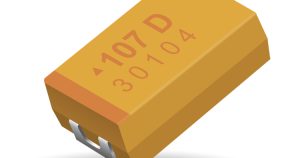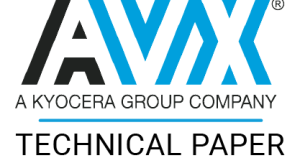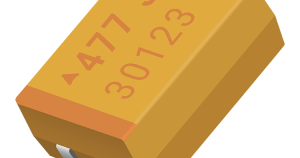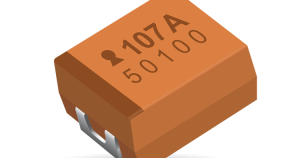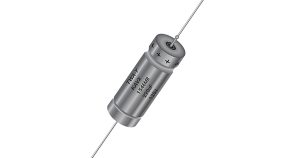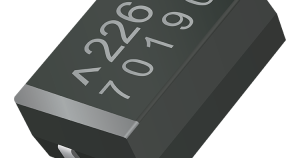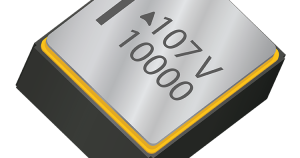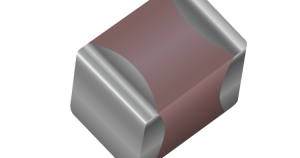Next Generation of High Voltage, Low ESR SMD Tantalum Conductive Polymer Capacitors Exceeds 100V Milestone Written By: T. Zedníček | M.Bárta | J.Petržílek | M.Uher | I.Horáček | J. Tomáško | L. Djebara Abstract: Tantalum capacitors designed for high voltage applications (above 25V) have been used for many years in telecommunication, industrial, automotive or other high reliability applications. The conventional high voltage tantalum capacitor design is using a manganese dioxide cathode that provides good reliability, stability and robustness. Nevertheless there are certain limitations. First of all it is the operating voltage – even with optimized processes of dielectric formation, rated voltages of such parts are mostly limited to 50 or 63V. The other limitation is ESR. Very low ESR values
Learn More →Technical Articles / Whitepapers
New Tantalum Technologies Tantalum Polymer and Niobium Oxide Capacitors Written By: T.Zedníček Abstract: Tantalum has been a favored capacitor technology in space-limited designs and high reliability applications for a long time. Recent years have seen the emergence of one or two equivalent technologies offering many of the advantages of tantalum, such as volumetric efficiency and reliability. Two new technologies recently introduced into their commercialization phase are niobium oxide capacitors and tantalum capacitors with conductive polymer cathodes. A circuit designer trying to choose between these solid electrolyte capacitor systems has a number of trade-offs and subtleties of operation to consider. This paper reviews the main features of the two technologies, the latest electronic application needs and discusses the feasibility of the
Learn More →Investigation Into the Effects of Connecting Tantalum Capacitors in Series Written By: J.A. Gill Abstract: This paper demonstrates how high voltage capacitors can be made by connecting lower voltage rated parts in series. How to create large banks of capacitance by parallel and series combinations of capacitors without sacrificing reliability is also discussed.
Learn More →Improved ESR on MnO2 Tantalum Capacitors at Wide Voltage Range Written By: I. Horacek | T. Zednicek | M. Komarek | J. Tomasko | S. Zednicek | W. A. Millman | J. Sikula | J. Hlavka Abstract: One common trend in switch-mode power supply, micro-processor, and digital circuit applications is to achieve reduced noise while operating at higher frequencies. In order to realize this, components with low Equivalent Series Resistance (ESR), high capacitance and high reliability are required. A new generation of Low ESR tantalum chip capacitors has been developed utilizing a low resistivity MnO2 electrolyte that enables very low component ESR. MnO2 technology provides excellent field performance, environmental stability and high electrical and thermal stress resistance in wide voltage
Learn More →High CV Wet Tantalum DC Capacitors Written By: T.Zedníček | J.Petržílek Abstract: There are very many DC back up applications that require high energy storage capability. Rechargeable batteries and double layer carbon capacitors, (Electric Double Layer Capacitors or EDLC), have certain limitations in high temperature and harsh operational conditions. This paper will describe a novel application and design concept approach that will introduce High CV wet tantalum capacitors into this arena. Comparisons with supercapacitors and conventional wet tantalum capacitors will be given, with benchmarking of the capacitor technologies.
Learn More →The Effects of ESR and ESL in Digital Decoupling Applications Written By: Jeffrey Cain, Ph.D Abstract: It is common place for digital integrated circuits to operate at switching frequencies of 100 MHz and above, even at the circuit board level. As these frequencies continue to increase, the parasitic of the decoupling capacitors must be considered. A study on the effects of equivalent series resistance (ESR) and equivalent series inductance (ESL) in a typical digital decoupling application is presented. Utilizing SPICE, it can be shown that the ESR and ESL of chip capacitors can dramatically alter the voltage seen by the integrated circuit (IC). By changing the values of the parasitics and comparing the results to the ideal case for a
Learn More →So Many Electrons, So Little Time… The Need for Low Inductance Capacitors Written By: John Galvagni | Sara Randall | Paul Roughan | Allen Templeton Abstract: High di/dt ratios, large current pulses over short times, are an inevitable part of today’s fast electronic circuitry. They can cause high voltage spikes when passing through paths that have inductance. The task of the designer then, is to have high energies available, but not the associated voltage excursions, by reducing the total inductance. Eliminating wire bonds, reducing path lengths, and using low inductance components is the regimen. This paper describes the availability of capacitors that can go a long way to providing the energies needed, but simultaneously, lower the intrinsic inductance it contributes.
Learn More →PE Series Capacitors Decoupling and/or Filtering Written By: John D. Prymak Abstract: Decoupling is a means of eliminating or reducing those elements which restrict high speed operations. Filtering is driven by two considerations – emission and susceptance. The noise generated in high speed digital operations may need to be reduced, to achieve accepted levels of emission to prevent interference with other systems. Also, the system itself may have its distinct level of noise tolerance which would require filtering selected inputs to maintain integrity of the logic circuit operations. The solution to a decoupling problem may assist filtering, and vice versa; but, the optimum solution to either is not the optimum solution for the other. The PE devices were originally designed
Learn More →Low Inductance Capacitors For Digital Circuits Written By: John Galvagni Abstract: Ceramic capacitors have become one of the limiting factors in digital circuits because of intrinsic characteristics such as equivalent series resistance and inductance. There are many things which could be done to mitigate that, and we describe some of those in this paper. AVX’s DCAP capacitor, (developed with and for IBM) is used as a benchmark to show how much can be done to improve the situation. We compare and contrast that part to those currently available.
Learn More →LICA® Design Guide Written By: Phil Troup Abstract: A review of high frequency decoupling basics highlighting the advantages of using LICA® with its C4 terminations in these applications.
Learn More →High CV Tantalum Capacitors Challenges and Limitations Written By: I.Horacek | T.Zednicek | S.Zednicek | T.Karnik | J.Petrzilek | P.Jacisko | P.Gregorova | I. Pinwill Abstract: The trend toward portable electronics is a major driving force in the need for miniaturisation of electronic components. Tantalum capacitors are becoming a product of first choice where high electrical and mechanical stability along with long service life and volumetric efficiency are demanded. The latest generation of ultra-high surface area tantalum powders in combination with an efficient constructional and encapsulation system provides a new solution for the next generation of component downsizing. This paper describes the main challenges and limitations in processes and materials that have been necessary to overcome for increased capacitance and
Learn More →Young’s Modulus and Thermal Diffusivity Measurements of Barium Titanate Based Dielectric Ceramics Written By: G. S. White and C. Nguyen National Bureau of Standards Gaithersburg, MD 20899 Bharat Rawal AVX Corporation Myrtle Beach, SC 29577 Abstract: Young’s modulus and thermal diffusivity values have been obtained on a set of barium titanate based ceramics using ultrasonic pulseecho and photoacoustic effect (PAE) measurements. The PAE was shown to detect variations in thermal diffusivity between materials of varying composition and processing treatments. The results are valuable in the evaluation of dielectric ceramic materials for practical electronics applications.
Learn More →Hermetically Sealed 230°C MnO2 Tantalum Capacitors Written By: T. Zednicek | M. Biler | J. Petrzilek | I. Pinwill Abstract: Certain electronic applications, such as oil and gas exploration drilling, are continuously demanding ever higher operating temperatures. Recently operating temperature requirements have increased from 200°C to 230°C with an increased operating life from hours to one thousand hours and beyond. This need is linked with the continuous development of oil drilling heads and sensors and their use for deeper drilling or drilling in more difficult geological conditions. Capacitors with high capacitance value are a common part of the electronic boards used in these applications, but over 125°C/175°C, available capacitor choice is very limited. Tantalum SMD capacitor technology has proved its
Learn More →Surface Mount Soldering Techniques and Thermal Shock in Multilayer Ceramic Capacitors Written By: John Maxwell Abstract: All components used in surface mount assemblies have temperature processing limitations that must be adhered to for maximum reliability. This paper discusses multilayer ceramic capacitors in detail and soldering process considerations that are valid for all SMT components.
Learn More →Some Observations on Recent MLCCs Quality as Experienced in Europe Including Discussion of Two Types of Dpa Analysis Written By: Dr. Phil Ward Abstract: A study of the European MLC quality by two types of DPA analysis shows that the newer formulations of 2F4 (Z5U) are as reliable as C0G (NP0) and 2C1 (X7R) formulations. These newer 2F4 formulations have small grain structure and low porosity which perform excellent on life test at 2xRV and load humidity 85ºC/85% RH at RV.
Learn More →Reliability of MLCCs After Thermal Shock Written By: Bharat S. Rawal | Michael Childs | Allan Cooper | Bill McLaughlin Abstract: With increasing use of multilayer ceramic capacitors in surface mount applications, the understanding of thermal shock properties of these devices is becoming increasingly important. Of the various soldering techniques utilized in surface mount applications, including wave soldering, vapor phase and infra red reflow techniques, wave soldering imposes the most severe thermal stresses on the MLCs. To simulate this process, parts are often dipped in solder baths. It will be shown in this paper that properties like critical stress intensity factor K1C, thermal diffusivity, Young’s modulus and the chip geometry are important for understanding the thermal shock behavior of chips.
Learn More →